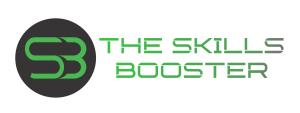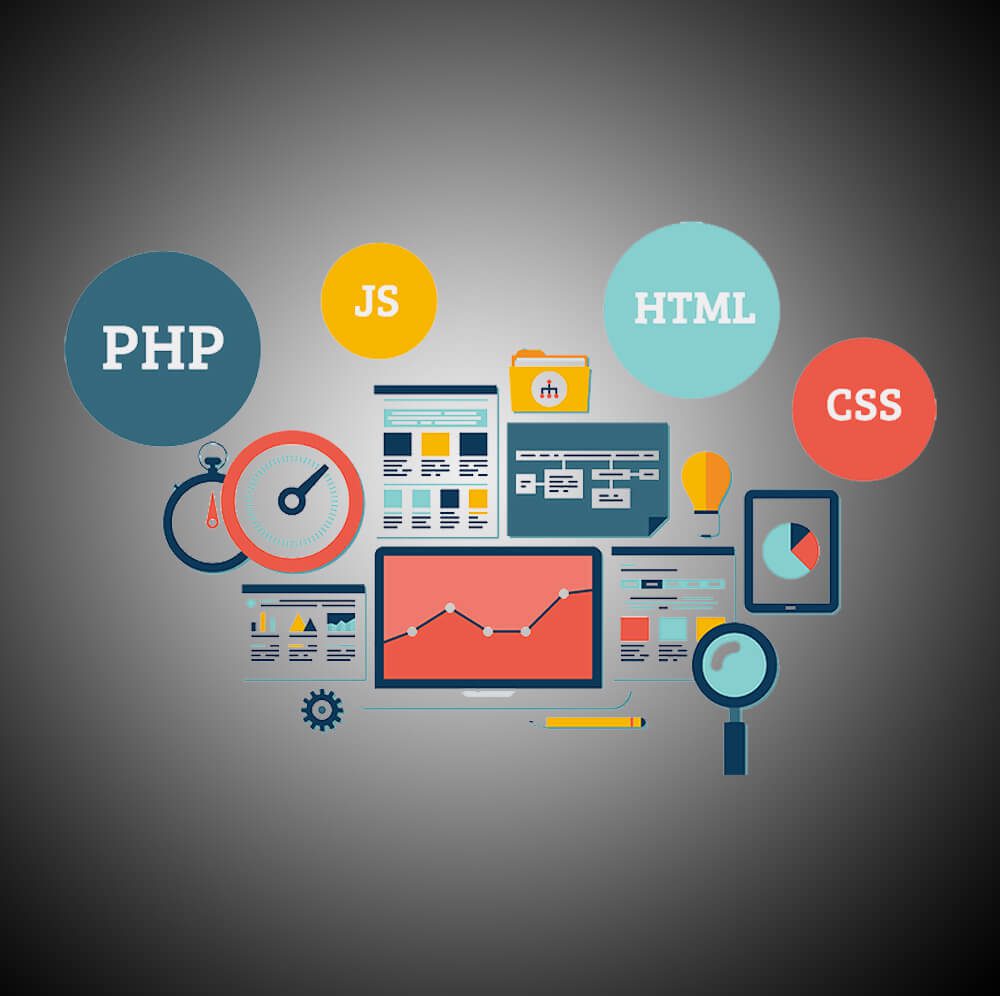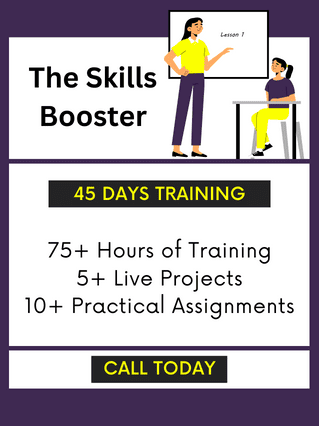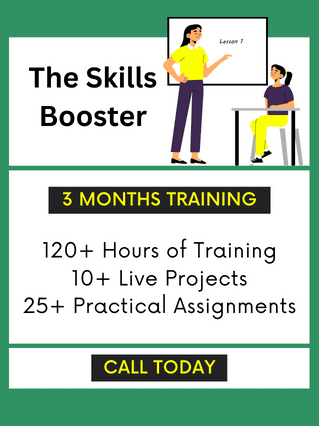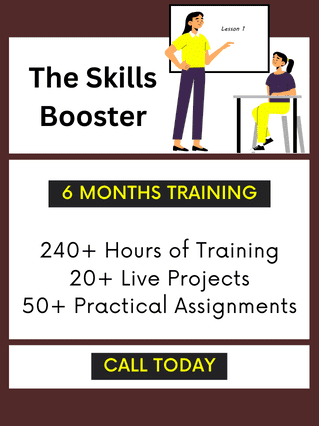In today’s digital age, having a strong online presence is essential for businesses and individuals alike. A well-designed website can make a significant impact on a brand’s visibility, credibility, and success.
This is where web designers come in – they are responsible for creating attractive, user-friendly, and functional websites that meet their clients’ needs and goals.
Web design is a constantly evolving field that requires a combination of technical skills, creativity, and attention to detail. As such, it is crucial for aspiring designers to have a solid foundation of knowledge and expertise. This is where the Skills Booster comes in – it is a comprehensive web design course that covers all the essential skills needed to become a professional web designer. Whether you are a beginner looking to start your career in web design or an experienced designer looking to upgrade your skills, the Skills Booster offers a complete learning experience.
With 30 modules covering topics such as HTML, CSS, JavaScript, UI/UX design, SEO, and project management, the course provides a hands-on approach with practical exercises, projects, and real-world scenarios to ensure you gain the skills and knowledge needed to succeed in the industry.
Enroll in the Skills Booster today for the best Industrial Training in Web Designing and unlock your potential as a web designer. Whether you’re looking to start your own business, work for an agency, or pursue a freelance career, the Skills Booster will equip you with the skills and knowledge needed to achieve your goals and succeed in the dynamic field of web design.
- Overview of web design and its importance
- Basics of HTML, CSS, and JavaScript
- Introduction to HTML
- HTML tags and attributes
- Creating HTML documents
- Structuring content with HTML
- Introduction to CSS
- CSS selectors
- CSS properties and values
- Styling HTML documents with CSS
- Introduction to JavaScript
- Variables and data types
- Operators and expressions
- Functions and control flow
- Introduction to responsive design
- Media queries
- Fluid layouts
- Flexible images and videos
- User interface design
- User experience design
- Wireframing and prototyping
- Design principles and best practices
- Introduction to typography
- Typefaces and fonts
- Type size and spacing
- Typography in web design
- Introduction to color theory
- Color models and color schemes
- Color psychology
- Using color in web design
- Introduction to images and graphics
- Image file types
- Image editing software
- Using images and graphics in web design
- Introduction to layout and grids
- Grid systems and frameworks
- Designing for different screen sizes
- Creating a layout with HTML and CSS
- Introduction to accessibility
- Web Content Accessibility Guidelines (WCAG)
- Designing for accessibility
- Testing for accessibility
- Introduction to search engine optimization (SEO)
- SEO best practices
- On-page SEO
- Off-page SEO
- Introduction to web hosting
- Types of web hosting
- Choosing a web host
- Domain registration and management
- Introduction to content management systems (CMS)
- Popular CMS platforms
- Installing and configuring a CMS
- Managing content with a CMS
- Introduction to e-commerce websites
- E-commerce platforms
- Payment gateways
- Designing an e-commerce website
- Introduction to website security
- Common security threats
- Preventing and detecting attacks
- Securing data and transactions
- Introduction to website maintenance
- Routine maintenance tasks
- Updating software and content
- Backing up and restoring data
- Introduction to web analytics
- Measuring website traffic and engagement
- Using analytics tools
- Analyzing and interpreting data
- Introduction to email marketing
- Building an email list
- Creating email campaigns
- Measuring email marketing success
- Introduction to social media marketing
- Social media platforms
- Creating social media content
- Measuring social media success
- Introduction to mobile app design
- Mobile app design principles
- Designing for different mobile platforms
- Testing and launching a mobile app
- Introduction to UI/UX design tools
- Sketch
- Figma
- Adobe XD
- Introduction to front-end frameworks
- Bootstrap
- Foundation
- Materialize
- Introduction to back-end development
- Server-side programming languages
- Databases and SQL
- RESTful APIs
- Introduction to version control
- Benefits of version control
- Git and GitHub
- Branching and merging
- Introduction to project management
- Agile methodology
- Scrum framework
- Project planning and execution
- Introduction to freelancing
- Finding clients and projects
- Pricing and invoicing
- Client communication and management
- Importance of a portfolio
- Types of portfolios
- Creating a portfolio website
- Showcasing skills and projects
- Job search strategies
- Creating a professional resume and cover letter
- Interview Preparation
- Communication and presentation skills
- Introduction to entrepreneurship
- Business planning and ideation
- Marketing and branding
- Launching and growing a business
Why The Skills Booster?
- The Skills Booster is the ultimate Industrial Training program in web designing course that covers all the essential skills needed to become a professional web designer.
- Whether you are a beginner or an experienced designer, the course offers a comprehensive curriculum that will enhance your skills and expertise.
- With 30 modules covering topics such as HTML, CSS, JavaScript, UI/UX design, SEO, and project management, the course provides a complete learning experience.
- The Skills Booster uses a hands-on approach with practical exercises, projects, and real-world scenarios to ensure that you gain the skills and knowledge needed to succeed in the industry.
- Enroll in the Skills Booster today and unlock your full potential as a web designer.
Enroll in the Skills Booster today and unlock your full potential as a web designer.
45 Days Industrial Training
For 45 days industrial training, the Skills Booster program can provide students with intensive training modules, focusing on specific areas of study. These modules are designed to equip students with the skills required to succeed in their industrial training program in a short amount of time. The program includes workshops, practical training sessions, and mentorship, allowing students to gain valuable experience and insight into their chosen field.
3 Months Industrial Training
For 3 months industrial training, the Skills Booster program can provide a more comprehensive approach to training. The program can offer students a more in-depth understanding of their chosen field, allowing them to gain a wider range of skills and knowledge. The program can also include industry visits, guest lectures, and networking opportunities, providing students with a holistic view of the industry and building their professional network.
6 Months Industrial Training
For 6 months industrial training, the Skills Booster program can provide students with a more immersive and hands-on experience. The program can offer students longer-term projects, giving them the opportunity to apply their skills and knowledge to real-life situations. Additionally, the program can include training in areas such as project management, team leadership, and communication, which are essential for success in any professional environment.
At The Skills Booster, we offer a comprehensive web Designing program that covers all these modules and more. Our program is designed to equip you with the skills and knowledge you need to succeed in today’s web Designing landscape. Our experienced instructors provide hands-on training and real-world examples to help students develop practical skills and apply their knowledge in a business context.
Contact us today to learn more about our Industrial Training in Web Designing and how we can help you achieve your career goals.

